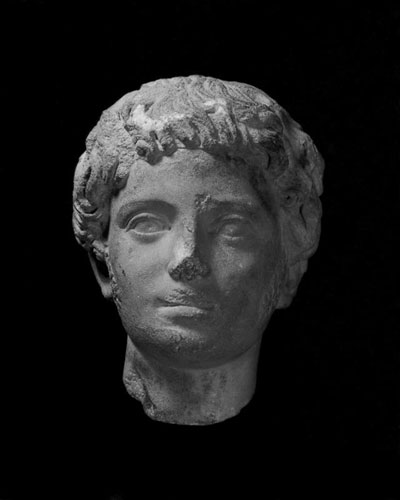
Although it is suggested that this marble bust from the University Museum’s collections was found on Cyprus, the pleasant-looking young man represented cannot thus far be identified. The very existence of his portrait shows that his family had some social status but his family name and the personal name by which his parents and school friends knew him are now lost or hidden in remnants of historical records. Yet a few personal remarks may be made about him.
This fellow’s hair style is not typically Roman, as carved by the sculptor. His heavy curling locks look very much like those shown in portraits of Antinous, the favorite of the emperor Hadrian. Antinous was of Greek extraction, living in Bithynia in Turkey. This boy, too, may very well have lived in some eastern Greek province of the empire. But it is wrong to call him a boy, for an unquestionable beard has begun to grow along his cheek and jaw line. He must be in his late teens. This was an important time of his life since he had already been recognized as an adult at the age of fifteen and now he was growing his first beard. Such a young man did not wait until the first down became embarrassingly obvious and then shave it off. He delayed this major operation until the growth was really heavy. Then it became the occasion for an important celebration.
Nero waited until he was twenty-two years old, but what a memorable time he had. He shaved his blond-red beard, collected every sliced hair and tucked them all into a golden ball which he carried off to the Capitoline Hill. There the ball was solemnly deposited in the temple of Jupiter Capitolinus as a dedicated offering. Then Nero ordered the beginning of the festival which had been carefully planned for this day. It was called the Juvenalia, the Celebration of Youth. But Nero seems to have considered some sort of a contrast rather appropriate and one wealthy matron in her eighties was encouraged to do a pantomimic dance. All families of noble status were expected to participate in some entertaining performance. Regardless of age or health they had to dance, sing, or express any other possible talents in the arts. Fearful of the young emperor’s displeasure and having been notified of this event beforehand, the aristocrats had hired teachers or attended special classes to prepare themselves. For weeks many blue-bloods had gone to bed with aching legs, hoarse throats, and finger tips worn because they couldn’t hold the plectrum correctly for plucking lyre strings. And all of this they had to suffer because Nero had his first shave.
That night, when all of the agony was over, everybody was entertained at dinner. Drifting around on boats in the Naumachia built more than a half century earlier by Augustus, they tried to enjoy the extravagant dishes prepared by Nero’s cooks. When the emperor sailed out through a canal into the Tiber at midnight they probably hoped that he would drown. Some undoubtedly remembered their history and wished that Rome had never seen its first Sicilian barber three hundred and fifty-nine years before. As much as they revered the memory of Scipio Africanus the Younger, they probably could have criticized him for making the daily shave popular.
The unknown young man in marble may not have recalled much about early Roman history but for him it was not very important. Shortly after his portrait was carved he would shave his beard. The hair would be placed in a container on the household shrine and within the family there would be a private celebration fully as important as anything Nero had planned.
